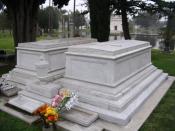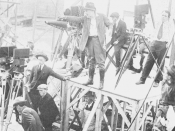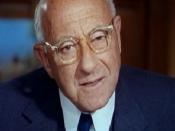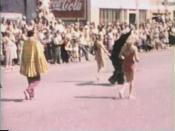Cecil B. DeMille "ÃÂ A True Auteur The cinema industry has had one of the most significant impacts on society in the twentieth century. Movies are directed in a wide variety of styles and techniques. One of these styles is defined by Francois Truffaut's auteur theory, which describes an auteur as a director who exhibits creative control over his or her works and has a distinctive personal style. Cecil Blount DeMille is considered by many to be the greatest director of all time, and a true auteur because of his insistence on realism and perfection, his characteristic use of wild sexual innuendo, and his massive studio productions.
In all of his seventy films, Cecil B. DeMille always insisted on precise detail and realism, and he did not hesitate to use any method to achieve it. For example, Cecil DeMille's older brother William DeMille once recalled a conversation in which they were filming a scene and Cecil insisted that they use real bullets instead of blanks.
When William told him that this was dangerous, Cecil replied, "Dangerous! Of course it's dangerous! ; who said it wasn't? But that's pictures. We don't fake anything in pictures ; we've got to have the real thing."ÃÂ This philosophy lasted for his entire directing career, and is clearly noticeable in all of his films. DeMille was a director who demanded perfection. When faced with a script, he often made drastic changes to fit his needs. He was very critical of the scripts, and oftentimes the original script looked nothing like the final script after DeMille had dissected it. "What I have crossed out I didn't like. What I haven't crossed out I am dissatisfied with."ÃÂ He was never satisfied with any of his films, and always strove to make enhance them further. DeMille's movies are also very noticeable through their attention to tiny details. For example, in the movie King of Kings, DeMille insisted that they used the real species of thorns supposedly worn by Jesus Christ.
According to the Catholic Encyclopedia Vol. IV and Kitlo's Encyclopedia Volume I, the crown of thorns was a branch of the bush Zizyphus Pina Christi which is noted for its long thorns"æwould suggest that we go down and steal this bunch at once.
In the Ten Commandments, biblical Egypt was recreated to the finest details. DeMille successfully depicted Egypt as it may have been during the time of Moses, through the exceptionally detailed architecture, clothing, and customs of the people. This brought about an aura of authenticity to the film, and enticed the audience into the world of Ancient Egypt. The Greatest Show on Earth was produced with the cooperation of the Ringling Brothers Barnum & Bailey Circus. DeMille used a real circus to produce the film, and was determined to show the public the most realistic story possible. "He gave this film his supreme and undivided attention to detail, pageantry, and publicity."ÃÂ This realistic approach put the fun and excitement of the circus onto the big screen, allowing the audience to experience it in an entirely new and enjoyable way. In Cleopatra, the palaces and streets of Ancient Rome looked authentic and worn, and the costumes were reminiscent of the time. The history was researched meticulously, and months were spent verifying tiny details such as the design of Egyptian hairpins and the correct pronunciation of Cleopatra's name. Similar to The Ten Commandments, this created an sense of legitimacy and helped capture the atmosphere of Ancient Rome and Ancient Egypt. Throughout his career as a director, DeMille always insisted on precise accuracy and detail, and was able to captivate audiences through his characteristic attentiveness to authenticity in all of his films.
One of the most unique and distinguishable aspects of DeMille's movies was his unrestrained use of wild sexual innuendo. In almost all of his films, the sexual suggestion was either unmistakably blatant or cleverly subtle. It was observed through the costumes, actions and dialogue of the characters. Although The Ten Commandments was a movie based on the Bible, there was nevertheless a great deal of sexual insinuation between Moses, Rameses, and Nefretiri. This was noticeable through many lines from the movie. Nefretiri was a princess of Egypt, and she was in love with Moses. When she said, "Allow them to worship any God they chose, as long as I can worship you,"ÃÂ she was expressing her love for Moses, even though she eventually became Rameses wife. The innuendo in this scene was more apparent combined with her facial expressions and her tone of voice, which subtly conveyed deeper sexual undertones. In the quote, "I know you, my sweet," which is said by Rameses to Nefretiri, the underlying meaning is sexual, as Rameses implies that he knows her sexually. DeMille used this type of subtle sexual innuendo throughout the movie to further develop the various characters, and also to keep the story interesting. Since the movie was biblically based, it was not appropriate to have blatant sexual innuendo, but DeMille used it in such a way that it blended into the movie seamlessly. Cleopatra is a movie in which the sexual innuendo is very obvious. All the women in the movie wear very seductive clothing, but it is Cleopatra herself who is the most provocative. This is apparent when she says to Marc Antony, I'm dressed to lure you, Antony...You see all this? It was all a plan - and you know why? Because it was my only chance. Don't you think I know you're my enemy - you and your hungry Rome? But I suppose it was the most stupid thing I could have done. What do you know - I had show after show with which to dazzle you. But Antony is not a man to be dazzled if he doesn't please, no. What do you care for this, for instance? Watch! After this, scantily clad dancing-girls begin to dance in front of Antony. The scene repeatedly cuts to Antony's face as he becomes enchanted by the girls. This display of sexual enticing was characteristic of all of DeMille's films. Another common device used in the 1930's which was also superbly utilized in Cleopatra was drunkenness as a metaphor for desire (Magills, pg 697). This is evident in the scene where Marc Antony has come to take Cleopatra away. She gets him drunk and it becomes obvious through their drunken gestures and speech that they both desire each other. Cleopatra was a movie based on Queen Cleopatra's ability to influence men through seduction. It was therefore only natural for there to be lots of sexual innuendo, since at the time censorship was a big issue and sexuality could not be openly portrayed. In The Greatest Show on Earth, there was a large amount of sexual overtones between the various performers, specifically between Sebastian, Brad, Holly and Angel. For example, Angel said to Sebastian, "Listen, sugar, the only way that you can keep me warm is to wrap me up in a marriage license."ÃÂ The implication in this quote is quite obvious, as the underlying meaning is of a sexual nature. The tones of the voices and the facial expressions in the movie were all of a suggestive theme. Some lines were more obvious, such as when Sebastian said to Holly, "If he should make love well after this, pay no attention - it will be me,"ÃÂ while Brad was receiving a blood transfusion from Sebastian. Clever lines like these were characteristic of DeMille productions. Cecil B. DeMille cherished the use of sexual innuendo, and he used it in a distinct and unique manner that creatively enhanced his films.
The sets were one of the most essential parts of DeMille's films, and he took every possible measure to ensure that they were superb. The set for the 1923 version of the Ten Commandments was the largest set ever built in movie history, and it was equally as stunning, possibly even better, in its rebuilt edition for the second version of the movie in 1956. It was called "The City of the Pharaoh"ÃÂ, and after filming was complete, DeMille ordered that the set be dismantled and secretly buried. When the Ten Commandments was released in 1923, its budget was over one million dollars. Today, that would translate into around eighty to ninety million dollars. It was an incredible amount of money back then, but when DeMille was questioned, he replied, "What do they want me to do? Stop now and release it as The Five Commandments? Money should not be an object when creating a Bible epic."ÃÂ The audience was struck by the brilliance and magnitude of the set. They had never before seen such exotic wonders, and were truly amazed by its splendor. The results of his persistence were very clear, as The Ten Commandments became one of the greatest and most memorable movies of all time. In Cleopatra, the costumes and sets were elaborately decorated and detailed. For example, Cleopatra's massive bordello was intricately designed and ornamented with silky draperies, falling rose petals, and dancing girls. The sets of Ancient Rome were very large and detailed as well. The audience was wowed by the splendor and magnificence of these sets. In The Greatest Show on Earth, the film included an entire circus, which demonstrated how DeMille was able to effectively use large sets to create stunning films. The circus was enormous, with hundreds of people involved, and it was very difficult for DeMille to direct such a large number of people. These people brought forth energy that reverberated throughout the film. This liveliness gave the film its vibrant and jovial nature. One of DeMille's greatest legacy's were his "larger-than-life, big-budget-films,"ÃÂ and through these films he attained everlasting success and fame.
Cecil B. DeMille had a typical formula for his movies ; extravagant costumes, massive sets, rampant sexual innuendo, forbidden love, and most of the time religious or traditionalist content. This formula never failed him and is the reason why so many of his movies are considered to be cinematic masterpieces. He was, "a captain of the Hollywood industry,"ÃÂ "the showman of showmen,"ÃÂ and, "the founder of Hollywood."ÃÂ There is no doubt that Cecil B. DeMille is an auteur. His movies were realistic and as close to perfection as possible, his use of sexual innuendo was a unique and distinguishable aspect of his directing style, and his movies were stunning successes produced on colossal sets. He was able to entertain the public in ways that had never been seen before, and will always be remembered as a cinematic genius and an indisputable auteur.





